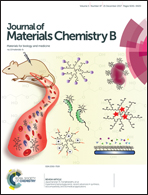Photoluminescent polyphosphazene nanoparticles for in situ simvastatin delivery for improving the osteocompatibility of BMSCs†
Abstract
Nanomedicines have found promising applications in regulating the biological behaviors of cells because of the cell endocytosis effect. To enhance the osteogenic differentiation of bone marrow mesenchymal stromal cells (BMSCs), which is one of the key issues in relation to bone regeneration, a biodegradable simvastatin-bearing polyphosphazene prodrug was synthesized and made into nanoparticles (NPs). At the same time, photoluminescent tryptophan ethyl ester and hydrolyzable glycine ethyl ester were introduced as co-substituted side groups onto the polyphosphazene backbone. The resultant polymer, poly(simvastatin-co-ethyl tryptophanato-co-ethyl glycinato)phosphazene (PTGP-SIM), displayed the expected features of photoluminescence, degradability and sustained SIM release. Endocytosis of PTGP-SIM NPs by BMSCs and the location of internalized NPs, were visualized via the inherent photoluminescence features of PTGP-SIM. Thus, simvastatin was released inside the cells directly along with polymer degradation and could play a role in promoting osteogenic differentiation efficiently at quite a low local concentration. From the results, the present study suggested a very promising biomaterial for use as a flexible and functional carrier for bioactive components, which could find wide applications in relation to tissue regeneration.



 Please wait while we load your content...
Please wait while we load your content...